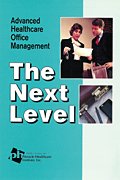








| |
|
|
|
|
| |
|
|
|
|
|
| Dynamic Chiropractic July 1, 2004, Volume 22, Issue 14 |
Printer Friendly Version E-mail to a Friend |
|
|
|||||||||||||
| Title: | The Next Level - Advanced Healthcare Office Management |
| Publisher: | Pinnacle Healthcare Institute, Inc., 1999 |
| Format: | Spiralbound, 234 pages |
| Part #: | T-590 |
 This book is divided into several main sections, with subchapters addressing specific topics. The main sections are: Office Matters, Physician Conduct, Staff Development, Managed Care, Medicare, Sample OSHA Compliance Plan, and Policy and Procedures. Some of the specific topics discussed include: successful mergers, group practices, communications, motivation, goal-setting, ownership of patient records, collections policies, and insurance follow-up. Of particular note is the 36-topic Policy and Procedures section. For offices that do not have an office policy manual, this information would be very helpful in getting started.
This book is divided into several main sections, with subchapters addressing specific topics. The main sections are: Office Matters, Physician Conduct, Staff Development, Managed Care, Medicare, Sample OSHA Compliance Plan, and Policy and Procedures. Some of the specific topics discussed include: successful mergers, group practices, communications, motivation, goal-setting, ownership of patient records, collections policies, and insurance follow-up. Of particular note is the 36-topic Policy and Procedures section. For offices that do not have an office policy manual, this information would be very helpful in getting started.
The title of this book is enough to intrigue most doctors. While the term "the next level" means something different to all of us, it signifies something that we each strive for and aspire to reach. Whether you are new in practice or nearing the end of a successful practice life, this book can help smooth the way to whatever your "next level" may be.
The section covering how to determine the value of a practice can be helpful to both new and retiring doctors. The section on managing accounts receivables and the section covering managed care are well-written. The section on staff management and motivation can help every doctor dodge the management pitfalls that lead to staff turnover, and avoid the disruption of continually finding and training new staff members.
Not that it takes away from the value of the information provided, but the pictures are extremely grainy and serve to distract more than they add. Additionally, some topics seem to offer very generalized information, and in some cases, simply restate the obvious, i.e., " It's fun to kid around but you don't do it at the other person's expense." Really?
Of course, every book has strengths and weaknesses. Overall, I believe this book would be especially useful as a teaching text for our chiropractic schools. It covers a multitude of topics that should be considered before graduation, such as book value vs. fair market value. It also introduces several office management concepts that most of us currently in the field had to learn by trial and error. This text could help to shorten the learning curve and reduce the stress we often endure while learning from our initial mistakes and missteps. Depending on your current level of management expertise, this book may simply serve as confirmation that you've got all the bases covered, or it may help provide the incentive to "bulletproof" the one or two areas of your practice that you've been meaning to get around to "tomorrow."
Dr. Edwards' Rating:
8.5 out of 10
![]()
Post your thoughts in our discussion forum

| Dynamic Chiropractic July 1, 2004, Volume 22, Issue 14 |
Printer Friendly Version E-mail to a Friend |
|
To report inappropriate ads, |